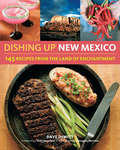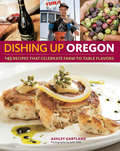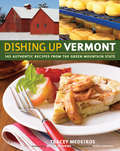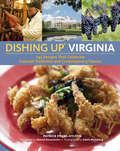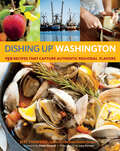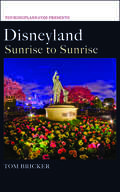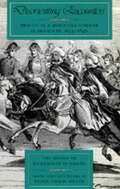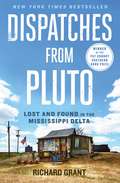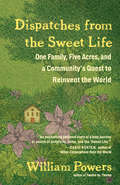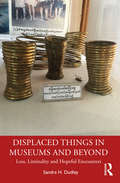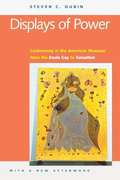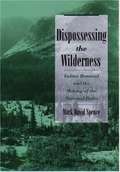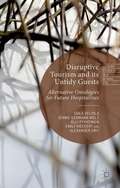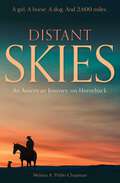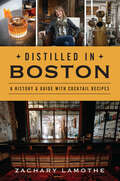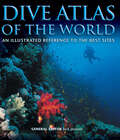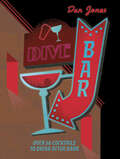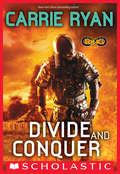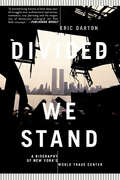- Table View
- List View
Dishing Up® New Mexico: 145 Recipes from the Land of Enchantment (Dishing Up®)
by Dave DeWitt Vicki PozzebonChow down on Calabicitas with Red Serranos and slake your thirst with a Prickly Pear Margarita. Dave Dewitt brings together 145 recipes that exemplify the diversity, ingenuity, and unique flavors of New Mexican cuisine. In addition to revealing the secrets behind regional delights ranging from Chipotle Pumpkin Seed Pesto to Spicy Chocolate-Raspberry Muffins, Dewitt offers a glimpse into New Mexico’s vibrant food scene with engaging profiles of local food producers. Pass the Buffalo Green Chile Eggrolls!
Dishing Up® Oregon: 145 Recipes That Celebrate Farm-to-Table Flavors (Dishing Up®)
by John Valls Ashley GartlandExplore Oregon’s varied and exciting food traditions. With delectable dishes that range from Hazelnut-Crusted Salmon with Balsamic Vinaigrette to Blackberry Bread Pudding and Flank Steak with Sorrel Salsa Verde to Rustic Pear Galette, Ashley Gartland covers the entire range of Oregonian cuisine. Profiles of local food producers are paired with stunning photography of Oregon’s farms, inns, and vineyards, bringing the state’s vibrant food and drink scene to life. Pass the locally sourced cranberry chutney!
Dishing Up® Vermont: 145 Authentic Recipes from the Green Mountain State (Dishing Up®)
by Tracey MedeirosFrom world-renowned cheddar cheeses to the delectable dinners turned out by talented chefs, the Green Mountain State has its own unique and rich food traditions. Learn new ways to use maple syrup, recreate that meal you enjoyed at a fancy restaurant, bake tree-ripened local apples into delicious desserts, and find out how the farmers growing the tastiest microgreens like to eat them. Filled with inspiring profiles of local food producers, Dishing Up® Vermont will quickly have you hooked on the joys of Yankee cooking.
Dishing Up® Virginia: 145 Recipes That Celebrate Colonial Traditions and Contemporary Flavors (Dishing Up®)
by Patrick Evans-Hylton Edwin Remsberg Marcel A. DesaulniersFrom colonial traditions through contemporary flavors, you’ll be amazed at the deliciously rich variety of Virginia’s cuisine. Patrick Evans-Hylton presents 145 delectable recipes celebrating the state’s oysters, blue crabs, peanuts, heirloom tomatoes, sweet potatoes, wine, and much more. Learn how to make Chesapeake Cioppino, Indian Butter Chicken, Black Cake, and scores of other regional delights. You’ll soon be pairing Classic Southern Slaw with Pulled Pork BBQ or Virginia Fried Chicken.
Dishing Up® Washington: 150 Recipes That Capture Authentic Regional Flavors (Dishing Up®)
by Jess ThomsonFrom Pacific salmon and Dungeness crab to wild mushrooms, cherries, apples, saffron, and much more, the Evergreen State’s diverse food traditions shine in this guide to Washington’s cuisine. Diverse recipes include Roasted Sockeye with Warm Orange and Olive Salad, Yukon Gold Potato Pizza, and Dark Chocolate Cake with Figs, Fennel, and Pistachios. You’ll also find inspiring profiles of Washington’s local food producers. With abundant seafood, fertile farmland, and award-winning vineyards, Washington has the ingredients for a deliciously varied culinary experience.
Dishwasher: One Man's Quest to Wash Dishes in All 50 States
by Pete JordanDishwasher is Public Radio favorite and underground celebrity Pete Jordan’s amusing memoir of his dishwashing extravaganza. Part adventure, part parody, and part miraculous journey of self-discovery, it is the unforgettable account of Jordan's transformation from itinerant seeker into "Dishwasher Pete"—unlikely folk hero, writer, publisher of his own cult zine, and the ultimate professional dish dog—and how he gave it all up for love.“For 12 years, I was the most prolific dishlicker of them all. From 1989 to 2001, I dished my way around the country, unwittingly searching for direction. From a bagel joint in New Mexico to a Mexican joint in Brooklyn; from a dinner train in Rhode Island to the Lawrence Welk Resort in Branson, Missouri; from an upper-crust ladies’ club to a crusty hippie commune—I washed the nation’s dishes. Whether it was a gig so lousy that I walked out within an hour or one where I toiled 120 hours a week, I remained a man on a mission: to bust suds in every state in the union.”—Pete JordanA smart, funny, and surprising look at life, Dishwasher is sure to appeal to fans of Nick Hornby and Tom Perotta.
Disney World, Universal Studios & Orlando 2015
by Jason CochranHome to the several, highly-exciting theme parks of Walt Disney World, Universal Studios, and Sea World, Orlando is one of the three most heavily-visited touristic locations in North America, which means that it receives tens of millions of visitors each year. Our author of this Easy Guide, Jason Cochran, has written an intensely-opinionated and often controversial guide to Orlando (where not to go, is one of his topics), based on numerous lengthy research trips there. Jason is a major travel journalist and is presently Editor-in-Chief of Frommers. com.
Disneyland: Sunrise to Sunrise
by Tom BrickerDisneyland: Sunrise to Sunrise is a collection of more than 200 photos from one single operational day in Disneyland, specifically "One More Disney Day," which was an event on Leap Day 2012 at Disneyland. On "One More Disney Day," Disneyland was open 24 consecutive hours. Tom captured all of the photos in the eBook during the course of that morning, day, night, and second morning. In so doing, Tom was one of the crazy Disneyland guests in the park on "One More Disney Day" from start to the very finish snapping hundreds of photos along the way to document the day.Disneyland: Sunrise to Sunrise highlights some of the best photos that Tom captured on that single operational day in Disneyland and presents them in one attractive eBook. Throughout the book Tom presents tidbits of trivia, such as the inspiration for the original Tomorrowland Moonliner and why Snow White was ultimately added to Snow White's Scary Adventures attraction in Fantasyland. If you're a fan of the Disney theme parks, you'll enjoy this fresh and beautiful look at one day in Disneyland.
Disorienting Encounters: Travels of a Moroccan Scholar in France in 1845-1846. The Voyage of Muhammad As-saffar (Comparative Studies nn Muslim Societies Series #14)
by Susan Gilson Miller Muhammed As-SaffarIn December of 1845, Muhammad as-Saffar was sent by the reigning Moroccan sultan on a special diplomatic mission to Paris. During the journey, as-Saffar took careful notes and upon his return he hurriedly wrote this travel account. <p><p> Why was the sultan, descendent of the Prophet Muhammad, and head of a dynasty that had ruled Morocco for more than two hundred years, so eager to read this account? Perhaps he thought it would illuminate some troubling matters: how the French acquired their power and their mastery over nature; how they led their daily lives, educated their children, treated their women and servants. In short, the sultan wanted to know the condition of French civilization and why it differed from his. As-Saffar provided the answers. <p><p> Moreover, as we read the account, Muhammad as-Saffar comes alive for us. We see him reflecting on the beauty of women, contorting during his ritual ablutions, and suffering from boredom at endless dinners. His opinions and ideas infuse every page. For him the journey was more than a catalog of curiosities; it was a transforming experience. Given our very limited knowledge of the time and the absence of other voices that speak with equal clarity, this travel account enlarges our understanding of the relationship between nineteenth-century Morocco and France.
Dispatches from Pluto: Lost and Found in the Mississippi Delta
by Richard GrantAdventure writer Richard Grant takes on "the most American place on Earth"--the enigmatic, beautiful, often derided Mississippi Delta.Richard Grant and his girlfriend were living in a shoebox apartment in New York City when they decided on a whim to buy an old plantation house in the Mississippi Delta. Dispatches from Pluto is their journey of discovery into this strange and wonderful American place. Imagine A Year In Provence with alligators and assassins, or Midnight in the Garden of Good and Evil with hunting scenes and swamp-to-table dining. On a remote, isolated strip of land, three miles beyond the tiny community of Pluto, Richard and his girlfriend, Mariah, embark on a new life. They learn to hunt, grow their own food, and fend off alligators, snakes, and varmints galore. They befriend an array of unforgettable local characters--blues legend T-Model Ford, cookbook maven Martha Foose, catfish farmers, eccentric millionaires, and the actor Morgan Freeman. Grant brings an adept, empathetic eye to the fascinating people he meets, capturing the rich, extraordinary culture of the Delta, while tracking its utterly bizarre and criminal extremes. Reporting from all angles as only an outsider can, Grant also delves deeply into the Delta's lingering racial tensions. He finds that de facto segregation continues. Yet even as he observes major structural problems, he encounters many close, loving, and interdependent relationships between black and white families--and good reasons for hope. Dispatches from Pluto is a book as unique as the Delta itself. It's lively, entertaining, and funny, containing a travel writer's flair for in-depth reporting alongside insightful reflections on poverty, community, and race. It's also a love story, as the nomadic Grant learns to settle down. He falls not just for his girlfriend but for the beguiling place they now call home. Mississippi, Grant concludes, is the best-kept secret in America.
Dispatches from the Gilded Age: A Few More Thoughts on Interesting People, Far-Flung Places, and the Joys of Southern Comforts
by Julia ReedDispatches from the Gilded Age is a collection of essays by Julia Reed, one of America's greatest chroniclers.In the middle of the night on March 11, 1980, the phone rang in Julia Reed’s Georgetown dorm. It was her boss at Newsweek, where she was an intern. He told her to get in her car and drive to her alma mater, the Madeira School. Her former headmistress, Jean Harris, had just shot Dr. Herman Tarnower, The Scarsdale Diet Doctor. Julia didn’t flinch. She dressed, drove to Madeira, got the story, and her first byline and the new American Gilded Age was off and running.The end of the twentieth century and the beginning of the twenty-first was a time in which the high and the low bubbled furiously together and Julia was there with her sharp eye, keen wit, and uproariously clear-eyed way of seeing the world to chronicle this truly spectacular era. Dispatches from the Gilded Age is Julia at her best as she profiles Andre Leon Talley, Sister Helen Prejean, President George and Laura Bush, Madeleine Albright, and others. Readers will travel to Africa and Cuba with Julia, dine at Le Bernardin, savor steaks at Doe’s Eat Place, consider the fashions of the day, get the recipes for her hot cheese olives and end up with the ride of their lives through Julia’s beloved South. With a foreword by Roy Blount, Jr. and edited by Julia's longtime assistant, Everett Bexley.
Dispatches from the Sweet Life: One Family, Five Acres, and a Community's Quest to Reinvent the World
by William PowersMany fantasize about dramatically changing their lives — living in accordance with their ideals rather than the exigencies of job, bills, and possessions. William Powers actually does it. In his book Twelve by Twelve, Powers lived in an off-grid tiny house in rural North Carolina. In New Slow City, he and his wife, Melissa, inhabited a Manhattan micro-apartment in search of slow in the fastest city in the world. Here, the couple, with baby in tow, search for balance, community, and happiness in a small town in Bolivia. They build an adobe house, plant a prolific orchard and organic garden, and weave their life into a community of permaculturists, bio-builders, artists, and creative businesspeople. Can this Transition Town succeed in the face of encroaching North American capitalism, and can Powers and the other settlers find the balance they’re seeking? Dispatches from the Sweet Life is compelling, sobering, thought-provoking, and, no matter the outcome, inspiring.
Displaced Things in Museums and Beyond: Loss, Liminality and Hopeful Encounters
by Sandra H. DudleyDisplaced Things in Museums and Beyond looks anew at the lives, effects and possibilities of things. Starting from the perspectives of things themselves, it outlines a particular, displacement approach to the museum, anthropology and material culture. The book explores the ways in which the objects are experienced in their present, displaced settings, and the implications and potentialities they carry. It offers insights into matters of difference and the hope that may be offered by transformative encounters between persons and things. Drawing on anthropological studies of ritual to conceptualise and examine displacement and its implications and possibilities, Dudley develops her arguments through exploration of displaced objects now in museums and dislocated or exiled from their prior geographical, historical, cultural, intellectual and personal contexts. The book’s approach and conclusions are relevant far beyond the museum, showing that even in the most difficult of circumstances there is agency, distinction and dignity in the choices and impacts that are made, and that things and places as well as people have efficacy and potency in those choices. In Displaced Things, displacement emerges as fundamental to understanding the lives of things and their relationships with human beings, and the places, however defined, that they make and pass within. The book will be essential reading for academics and students engaged in the study of museums, heritage, anthropology, culture and history.
Displays of Power: Controversy in the American Museum From the Enola Gay to Sensation!
by Steven C. DubinMuseums have become ground zero in America's culture wars. Whereas fierce public debates once centered on provocative work by upstart artists, the scrutiny has now expanded to mainstream cultural institutions and the ideas they present. In Displays of Power, Steven Dubin, whose Arresting Images was deemed "masterly" by the New York Times, examines the most controversial exhibitions of the 1990s. These include shows about ethnicity, slavery, Freud, the Old West, and the dropping of the atomic bomb by the Enola Gay. This new edition also includes a preface by the author detailing the recent Sensation! controversy at the Brooklyn Museum. Displays of Power draws directly upon interviews with many key combatants: museum administrators, community activists, curators, and scholars. It authoritatively analyzes these episodes of America struggling to redefine itself in the late 20th century.
Dispossessing the Wilderness: Indian Removal and the Making of the National Parks
by Mark David SpenceNational parks like Yellowstone, Yosemite, and Glacier preserve some of this country's most cherished wilderness landscapes. While visions of pristine, uninhabited nature led to the creation of these parks, they also inspired policies of Indian removal. By contrasting the native histories of these places with the links between Indian policy developments and preservationist efforts, this work examines the complex origins of the national parks and the troubling consequences of the American wilderness ideal. The first study to place national park history within the context of the early reservation era, it details the ways that national parks developed into one of the most important arenas of contention between native peoples and non-Indians in the twentieth century.
Disruptive Tourism and its Untidy Guests
by Soile VeijolaThis book invokes the radical potentialities of 'untidiness' to envision alternative arrangements of social life and hospitality. Instead of trying to manage sustainability or tidy up tourist situations, the authors embrace the messiness of human relations and argue for more creative, embodied and ethical ontologies of tourism and mobility.
Distant Skies
by Melissa A Priblo ChapmanMelissa Chapman was 23 years old and part of a happy, loving family. She had a decent job, a boyfriend she cared about, and friends she enjoyed. Yet she said goodbye to all of it. Carrying a puppy named Gypsy, she climbed aboard a horse and rode away from everything, heading west.With no cell phone, no GPS, no support team or truck following with supplies, Chapman quickly learned that the reality of a cross-country horseback journey was quite different from the fantasy. Her solo adventure would immediately test her mental, physical, and emotional resources as she and her four-legged companions were forced to adapt to the dangers and loneliness of a trek that would span over 2,600 miles, beginning in New York State and reaching its end on the other side of the country, in California.Enchanted by the freedom a nomadic life seemed to promise, the young woman would soon find herself only more deeply connected—to the animals that accompanied her, to the varying and challenging landscapes through which she traveled, and to the people she met on the farms and back roads that crisscross the United States. Her tale is part American road trip, part coming-of-age adventure, and part uncommon love story—a remarkable memoir that explores the evolution of the human-animal relationship, along with the raw beauty of a life lived outdoors.
Distilled in Boston: A History & Guide with Cocktail Recipes (American Palate)
by Zachary LamotheBoston has a long history with distilled spirits, from Colonial times through Prohibition. More recently, there has been a resurgence in the craft distilling industry from Cape Ann to Cape Cod. Regional standouts such as Boston Harbor Distillery, Bully Boy Distillers and Short Path Distillery have opened up a new era, with more than a dozen new businesses now on the scene. The ingredients, production processes and marketing techniques are as varied as the beverages themselves. Join author Zack Lamothe as he reveals the backstory of the popular craft spirit movement in the greater Boston area.
Dive Atlas of the World: An Illustrated Reference to the Best Sites
by Jack JacksonExplore the top dive sites around the world, from Lawson Reef to the Red Sea to the Great Barrier Reef, in this stunning guide.The Dive Atlas of the World offers a tour of the world’s dive sites, described and photographed by experts. From well-known classics to sites which have only recently been discovered, this global selection offers the discerning diver a feast of locations to choose from. Whether you favour muck diving and macro photography, wrecks, walls, reefs, caves, blue holes or the adrenaline rush of a high-speed drift dive in a strong current (or all of these), you will find well-written, clearly mapped accounts of the top places where you can enjoy these dives.With contributions from local experts, leading writers and award-winning underwater photographers: Jack Jackson, Lawson Wood, Michael Aw, Paul Lees, Dr Charles Anderson, Sam Harwood, Judy and Bruce Mann, Chris Fallows, Stefania Lamberti, Ann Storrie, Mark and Charlotte Durham, Alan Mountain, Andy and Angie Belcher, Bob Halstead and Wade Doak.Three hundred-page fully updated global guide to the world’s top dive sitesWritten by experienced dive authors, based on their first-hand experienceInspirational reference for divers who wish to personally or vicariously experience the best diving the planet has to offerHelps you select and locate the type of diving experience you are looking forSuperb quality underwater photography shows famous wrecks, a wide range of marine habitats, and a huge diversity of speciesAppendix with lists of travel and dive information, climate, best time to go, contacts, dive operators, and emergency facilities
Dive Bar: Over 50 cocktails to drink after dark
by Dan JonesIn his new cocktail collection, expert mixer Dan Jones proves that rough-around-the-edges dive bars provide the perfect inspiration for your homemade drinks. After all, if the bartender in a low-lit, sticky-carpeted, no-frills establishment can churn out a faultless Manhattan or the Dirty Martini of your dreams, that means you can do it too!Dan starts by detailing the basic cocktail kit, but never fear: an empty pickle jar for shaking and a spoon for swizzling will do the trick. With over 50 recipes, featuring chic classics and modern concoctions, single serves and jugs of joy, you won't know where to begin. To set the mood, Dan explores the greatest dive bars across the globe and offers up the best karaoke song or dirty snack to accompany your tipple.So whether it's a cocktail party or an unplanned drinkathon, let Dive Bar inject some magic into your next soiree.
Dive Bar: Over 50 cocktails to drink after dark
by Dan JonesIn his new cocktail collection, expert mixer Dan Jones proves that rough-around-the-edges dive bars provide the perfect inspiration for your homemade drinks. After all, if the bartender in a low-lit, sticky-carpeted, no-frills establishment can churn out a faultless Manhattan or the Dirty Martini of your dreams, that means you can do it too!Dan starts by detailing the basic cocktail kit, but never fear: an empty pickle jar for shaking and a spoon for swizzling will do the trick. With over 50 recipes, featuring chic classics and modern concoctions, single serves and jugs of joy, you won't know where to begin. To set the mood, Dan explores the greatest dive bars across the globe and offers up the best karaoke song or dirty snack to accompany your tipple.So whether it's a cocktail party or an unplanned drinkathon, let Dive Bar inject some magic into your next soiree.
Diversity Competence: Cultures Don’t Meet, People Do
by Dr Edwin Hoffman Arjan VerdoorenIn today's world many people live, learn and work in international and multicultural environments. Intercultural communication has become an important topic in many fields of work and study. Given the complexities of globalization, knowledge of cultures and cultural differences is rarely sufficient. In this book, interpersonal communication forms the point of departure: the meeting of people, not of cultures. The authors describe what diversity competence entails: which processes, challenges and skills are relevant in a 'superdiverse' world. They demonstrate how the TOPOI model offers an inclusive, communicative approach to analyzing and addressing potential miscommunication. - Addresses controversial topics frankly and clearly without being simplistic. - Discusses theory from several different fields. - Case studies provide practical examples and guidelines. - Companion website with extra case studies and study assignments. The target audience for Diversity Competence includes students, educators and professionals in the fields of communication and media, business, management and leadership, governance and international relations and cooperation.
Diversity Competence: Cultures Don’t Meet, People Do
by Dr Edwin Hoffman Arjan VerdoorenIn today's world many people live, learn and work in international and multicultural environments. Intercultural communication has become an important topic in many fields of work and study. Given the complexities of globalization, knowledge of cultures and cultural differences is rarely sufficient. In this book, interpersonal communication forms the point of departure: the meeting of people, not of cultures. The authors describe what diversity competence entails: which processes, challenges and skills are relevant in a 'superdiverse' world. They demonstrate how the TOPOI model offers an inclusive, communicative approach to analyzing and addressing potential miscommunication. - Addresses controversial topics frankly and clearly without being simplistic. - Discusses theory from several different fields. - Case studies provide practical examples and guidelines. - Companion website with extra case studies and study assignments. The target audience for Diversity Competence includes students, educators and professionals in the fields of communication and media, business, management and leadership, governance and international relations and cooperation.
Divide and Conquer (Infinity Ring #2)
by Carrie RyanScholastic's next multi-platform mega-event begins here!Dak, Sera, and Riq might be in over their heads when they attempt to stop a Viking invasion!Hundreds of ships carrying thousands of warriors are laying siege to medieval Paris. The Parisians are holding their own, but the stalemate can only last so long. And that's bad news -- especially since Dak has been captured, forced to work alongside the Vikings while Sera and Riq defend Paris from within. No matter which side wins, the kids lose!
Divided We Stand: A Biography of New York's World Trade Center
by Eric DartonWhen the World Trade Towers in New York City were erected at the Hudson’s edge, they led the way to a real estate boom that was truly astonishing. Divided We Stand reveals the coming together and eruption of four volatile elements: super-tall buildings, financial speculation, globalization, and terrorism. The Trade Center serves as a potent symbol of the disastrous consequences of undemocratic planning and development. This book is a history of that skyscraping ambition and the impact it had on New York and international life. It is a portrait of a building complex that lives at the convergence point of social and economic realities central not only to New York City but to all industrial cities and suburbs. A meticulously researched historical account based on primary documents, Divided We Stand is a contemporary indictment of the prevailing urban order in the spirit of Jane Jacobs’s mid-century classic The Death and Life of Great American Cities.
